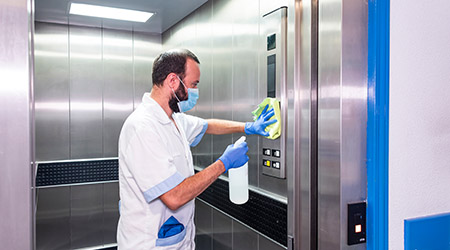Adequate disinfection of environmental surfaces, particularly high-touch surfaces, is a cornerstone for infection control and prevention. This becomes even more important during a pandemic such as the one we are all currently experiencing.

It is time for a reality check when it comes to disinfecting environmental surfaces. A huge gap remains between government registration protocols for disinfectants and processing an Emergency Department Trauma Room after a gunshot victim has received life-saving medical treatment. The disinfectant the environmental services technician (EST) uses to clean up blood, bone and human tissue was purchased with input
from the Infection Prevention department. Unfortunately, though, many such disinfectants are either ineffective for the purpose and/or used improperly.
Why? There are four big reasons:
- The registration process for healthcare-grade disinfectants is based on flawed methods for microbicidal activity. A chemical disinfectant is tested against Gram-positive and Gram-negative bacteria only, but the label claims “broad spectrum activity.” According to Dr. Syed A Sattar, “The use of this antibiotic-relevant term is totally inappropriate for disinfectants. The correct use of the term must be given a disinfectant’s ability to inactivate not only vegetative bacteria but viruses and fungi as well, which are common nosocomial pathogens. Therefore, the registration number on the product label itself is of limited value.”
- Disinfectants are tested without any wiping action. When the EST is processing the aftermath in the Trauma Room, the gurney isn’t submerged in disinfectant for 10 minutes as the label states for contact time; although that is how the product testing is performed. The real world is an EST employing a microfiber wipe, a disinfectant and “elbow grease” to clean and disinfect surfaces and equipment according to hospital protocols. The mechanical action of wiping contributes significantly to soil removal and rendering surfaces “safe, clean and disinfected.”
- Organic load or material is dirt (blood serum, protein, food, body waste and so on) that will disable the chemical, keeping it from disinfecting that surface. Disinfectants have varying levels of organic load they can tolerate. The label statement: “effective against stated germs in the presence of 5 percent serum” indicates a product is a one-step cleaner disinfectant and is effective in the presence of a small amount of organic soil. The problem is fecal matter the size of a pinhead contains more than enough infective material to transmit Clostridium-difficile. When soil load exceeds 5 percent (which isn’t visible) the active ingredients in the disinfectant are less effective in killing pathogens of concern.
- Currently, disinfecting without precleaning is considered an off-label use for EPA-registered products. However, research is needed to determine the conditions under which a 1-step process using a combined detergent-disinfectant product can be as effective for reducing contamination on surfaces as a 2-step process in which cleaning is followed by disinfection. This research should evaluate the impact of the presence of organic matter on the surface. A 1-step process could simplify the number of products that environmental services workers are required to use and may prevent confusion and inappropriate use that is more likely when multiple products are required.
Contact time refers to how long you must leave a disinfectant on a surface for it to do everything the label says it will. However, there is a universal misunderstanding of the meaning of dwell or contact time for disinfectants.
Myth: The contact time on a disinfectant’s label is the time a surface must remain wet for the disinfectant to kill the listed organisms.
Fact: 10-minute contact time is meant for EPA registration, not the time it takes to kill microorganisms on pre-cleaned surfaces. The only way an institution can achieve a contact time of 10 minutes is to reapply the surface disinfectant 5 to 6 times to the surface as the typical dry time for a disinfectant is 1.5 to 2 minutes. Healthcare facilities are achieving surface disinfection of non-critical patient care items and environmental surfaces by one application of a disinfectant and requiring a greater than 1-minute dry time.
In closing, environmental services managers and their team members are guardians of the health of people and the environment. Be educated and vigilant in your pursuit of safe and environmentally responsible cleaning and disinfecting methods. Keeping the indoor environment clean and safe truly matters.
J. Darrel Hicks, BA, MESRE, CHESP, Certificate of Mastery in Infection Prevention is the Past President of the Healthcare Surfaces Institute. Hicks is nationally recognized as a subject matter expert in infection prevention and control as it relates to cleaning. He is the owner/principal of Safe, Clean and Disinfected. His enterprise specializes in B2B consulting, webinar presentations, seminars and facility consulting services related to cleaning and disinfection. He can be reached at [email protected] or you can learn more at www.darrelhicks.com.
